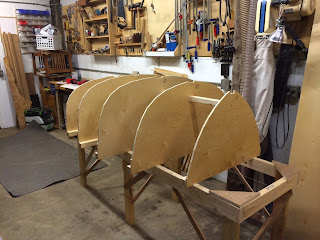fitting the keel

Today is Christmas Eve -- not much boat building in recent days, but while finishing up a project for the holidays, I took time to fit the keel and work out how to fit it around the daggerboard trunk. I confess to having miss-cut a version a few days back which made evident the need to do a carefully measured lay out. I used a scrap of the Okume plywood (foreground), and took measurements every 3 inches to define the bottom curvature. I cut out and smoothed this pattern until I was happy, then traced it onto the Alaskan yellow cedar blank. I band-sawed the piece, and did some further shaping with a block plane and sanding block. I'll do some additional tweaking of the fit and taper and shape the skeg portion, and laminate sisters to the portion adjacent to the daggerboard, and taper them.

























